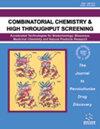藿香正气水基于生物信息学和实验验证的胃癌癌前病变治疗有望候选药物
IF 1.6
4区 医学
Q4 BIOCHEMICAL RESEARCH METHODS
Combinatorial chemistry & high throughput screening
Pub Date : 2024-09-18
DOI:10.2174/0113862073325718240827073225
引用次数: 0
摘要
背景:胃癌癌前病变(PLGC)是胃癌发展的早期阶段。临床应用 HPXLD 对治疗 PLGC 有一定疗效,但 HPXLD 对 PLGC 的作用机制尚不清楚。研究目的本研究旨在揭示HPXLD如何用于治疗PLGC的分子机制,并通过生物信息学和实验验证对该机制进行研究。方法:通过生物信息学分析确定与PLGC相关的靶基因。使用N-甲基-N'-硝基-N-亚硝基喹尼丁(MNNG)联合雷尼替丁、热盐水、乙醇和间歇性禁食诱导大鼠PLGC模型,并使用HPXLD进行干预。通过苏木精-伊红染色(HE)评估胃黏膜的病理改变。免疫组织化学(IHC)和 Western 印迹分析用于评估炎症相关蛋白表达水平的变化。结果经过生物信息学分析,发现有23个HPXLDPLGC交叉基因在IL-17信号通路、TNF信号通路和NF-kappa B信号通路中明显富集。HE 结果显示,HPXLD 能有效改善胃黏膜组织病理学变化。此外,IHC结果显示,HPXLD能够下调IL-6、COX-2、MCP-1和MMP-9的表达。此外,Western 印迹分析显示,HPXLD 能够下调 IL-6、IL-17RA、ACT1、NF-κB 和 TNF-α 的表达。结论研究表明,HPXLD 可通过减少炎症相关蛋白的表达来改善 PLGC。这表明 HPXLD 有可能成为 PLGC 的一种治疗选择。本文章由计算机程序翻译,如有差异,请以英文原文为准。
Huopuxialing Decoction: A Promising Candidate for Precancerous Lesions of Gastric Cancer Treatment Based on Bioinformatics and Experimental Verification
Background: The Precancerous Lesion of Gastric Cancer (PLGC) is an early stage in the development of gastric cancer. The clinical application of HPXLD has been found to be effective in treating PLGC, but the mechanism of how HPXLD acts on PLGC is still unclear. Objective: The objectives of this study were to reveal the molecular mechanism of how HPXLD can be used to treat PLGC and investigate this mechanism through bioinformatics and experimental validation. Methods: PLGC-associated target genes were identified through bioinformatics analysis. A rat model of PLGC was induced using N-methyl-N'-nitro-N-nitrosoquanidine (MNNG) in combination with ranitidine, hot saline, ethanol, and intermittent fasting, with interventions by HPXLD. The pathological alterations in gastric mucosa were assessed through Hematoxylin-eosin staining (HE). Immunohistochemistry (IHC) and Western blot analyses were employed to evaluate the changes in expression levels of inflammation-related proteins. Results: After conducting bioinformatics analysis, it was found that there were 23 HPXLDPLGC crossover genes, which were significantly enriched in the IL-17 signaling pathway, TNF signaling pathway, and NF-kappa B signaling pathway. The results of HE showed that HPXLD was effective in improving gastric mucosal histopathological changes. Additionally, the IHC results demonstrated that HPXLD was able to downregulate the expression of IL-6, COX-2, MCP- 1, and MMP-9. Furthermore, Western blot analysis revealed that HPXLD was able to downregulate the expressions of IL-6, IL-17RA, ACT1, NF-κB, and TNF-α. Conclusion: HPXLD has been shown to improve PLGC by reducing the expression of inflammation- related proteins. This suggests that HPXLD may potentially be a treatment option for PLGC.
求助全文
通过发布文献求助,成功后即可免费获取论文全文。
去求助
来源期刊
CiteScore
3.10
自引率
5.60%
发文量
327
审稿时长
7.5 months
期刊介绍:
Combinatorial Chemistry & High Throughput Screening (CCHTS) publishes full length original research articles and reviews/mini-reviews dealing with various topics related to chemical biology (High Throughput Screening, Combinatorial Chemistry, Chemoinformatics, Laboratory Automation and Compound management) in advancing drug discovery research. Original research articles and reviews in the following areas are of special interest to the readers of this journal:
Target identification and validation
Assay design, development, miniaturization and comparison
High throughput/high content/in silico screening and associated technologies
Label-free detection technologies and applications
Stem cell technologies
Biomarkers
ADMET/PK/PD methodologies and screening
Probe discovery and development, hit to lead optimization
Combinatorial chemistry (e.g. small molecules, peptide, nucleic acid or phage display libraries)
Chemical library design and chemical diversity
Chemo/bio-informatics, data mining
Compound management
Pharmacognosy
Natural Products Research (Chemistry, Biology and Pharmacology of Natural Products)
Natural Product Analytical Studies
Bipharmaceutical studies of Natural products
Drug repurposing
Data management and statistical analysis
Laboratory automation, robotics, microfluidics, signal detection technologies
Current & Future Institutional Research Profile
Technology transfer, legal and licensing issues
Patents.

 求助内容:
求助内容: 应助结果提醒方式:
应助结果提醒方式:


